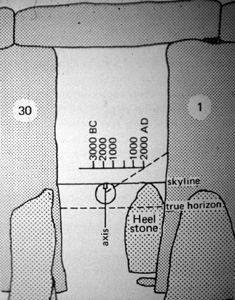He hypothesised that this was because their foundations were laid to align with the rise of the Sun on that day. To test his hypothesis he studied Karnac one of the great temples in Egypt and published his results in ``The Dawn of Astronomy'' 1894.
He continued this work investigating sunrise alignments on many other ancient temples and even tried to use this idea to date Stonehenge! Unfortunately his method was flawed and so his answer of 1680 BC is not correct. It is now known that the heel stones at Stonehenge were laid in about 2150 BC.
Lockyer's belief that Stonehenge and other stone circles had astronomical purposes has been the primary impetus behind the research of this area in the twentieth century. For this reason he has been called the "father of achaeoastronomy."

Lockyers method of trying to date Stonehenge.